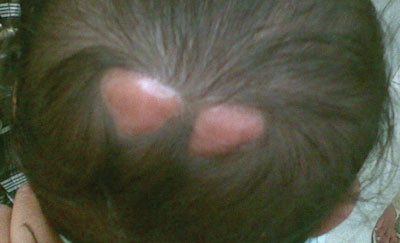A 9-month-old child presented with two
localized areas of hair loss over the occipital region,
noticed by the parents since the age of three months.
Parents did not report any history of trauma, redness,
swelling, erosion or ulceration prior to the onset of hair
loss. None of the family members had similar complaints. The
patient had been treated with topical antifungal and
steroids for two months without any improvement. Examination
revealed two well demarcated triangular patches of
non-scarring alopecia, in the occipital area; the base of
the triangles was towards the vertex (Fig. 1).
The overlying skin was smooth and shiny with no scaling or
erythema. Exclamation mark hairs were absent. Examination of
nails did not show ridging or pitting. The triangular shape
of alopecia, absence of exclamation hair and lack of
response to any treatment in past led us to the diagnosis of
Congenital triangular alopecia. Counselling of the parents
was done about the poor prospect of hair regrowth and option
of hair transplantation in future.
 |
|
Fig.1 Congenital triangular
alopecia.
|
Congenital triangular alopecia or Brauer
nevus, is a benign, non progressive, circumscribed and
non-scarring form of alopecia usually present over the
temporal region. Other conditions that should be considered
under differential diagnosis are alopecia areata (round or
oval patches of rapid and complete hair loss with
exclamation point hairs, pitted nails and tapered fractures
on the hair counts), aplasia cutis (solitary or multiple
well demarcated oval or circular atrophic fibrotic scars or
ulcerations), tinea capitis (itchy, scaly or erythematous
ring lesions with greyish, lustreless, brittle and broken
hairs) and trichotillomania (irregular areas of incomplete
hair loss in occipital or parietal areas of scalp).

